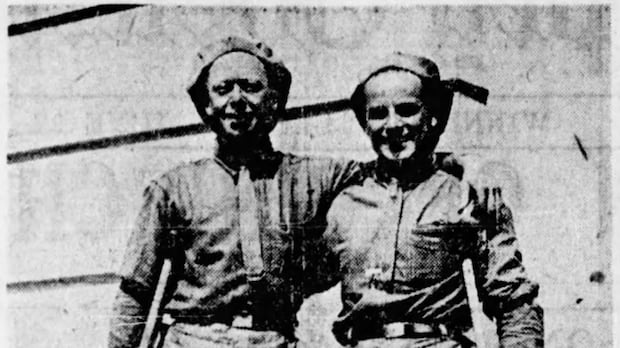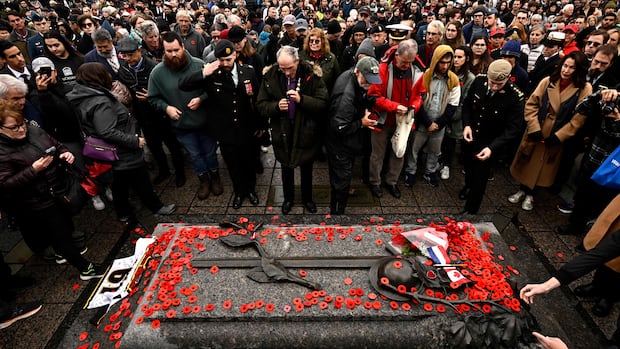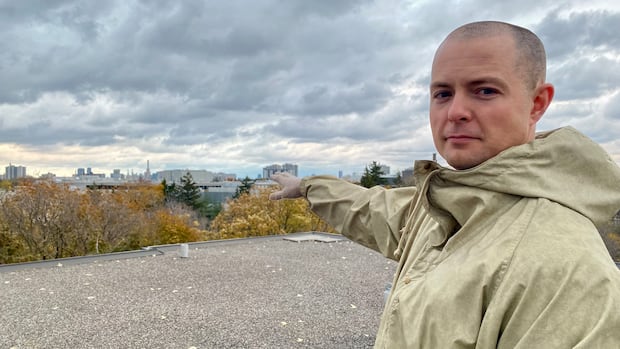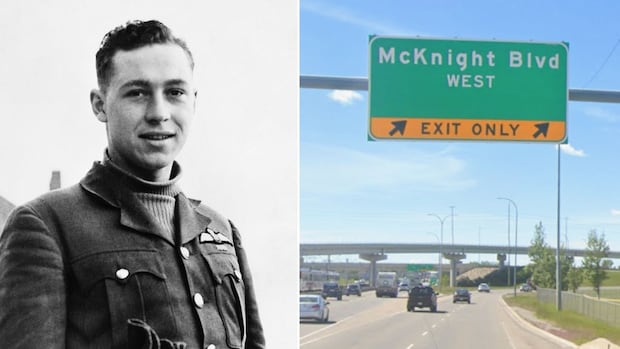More than 100 years ago, George Hincks and Marshall McDougall met in a Calgary military hospital and hatched a truly spectacular plan.
It was 1923, and both men were struggling to reintegrate into society after they each lost a leg during the First World War. Tired of being underestimated because of their disabilities, they decided to hike, on crutches, from Alberta to Ontario.
They embarked on their journey almost 60 years before Terry Fox made history with his Marathon of Hope.
But unlike Fox, Hincks and McDougall have been, by and large, forgotten by history — until historian Eric Story came across their names in an old military magazine and decided to share their incredible feat.
“It's truly unfathomable,” Story, a postdoctoral researcher at Western University in London, Ont., told As It Happens host Nil Köksal. “They're hiking 30 kilometres per day for almost two months ... and the technologies, the prosthetic technologies, crutches, they're not like they are today.”
‘A pretty exciting story’Calgary’s Lauren McDougall, Marshall McDougall’s great-grandniece, came across the story herself a while back when she was researching her family tree and said she’s thrilled to see this buried history brought to light.
“I never understood why I didn't know of any of these people before my own research on them,” she told Köksal. “It's kind of crazy, but it's a pretty exciting story."
Her great-granduncle, she said, was known for having “a pretty good sense of humour and a positive energy."
LISTEN | Interview with Eric Story and Lauren McDougall:As It Happens7:30Decades before Terry Fox, these WW I amputees hiked across much of Canada on crutches
So she suspects that when he and Hincks first hatched their plan in that Calgary hospital all those decades ago, he simply saw it as a fun challenge between two pals. But it quickly transformed into so much more.
“They do an amazing thing to bring awareness to the communities as they're going about what needs to happen and what supports need to be in place for these soldiers returning from the war, and especially those affected by amputation,” Lauren McDougall said.
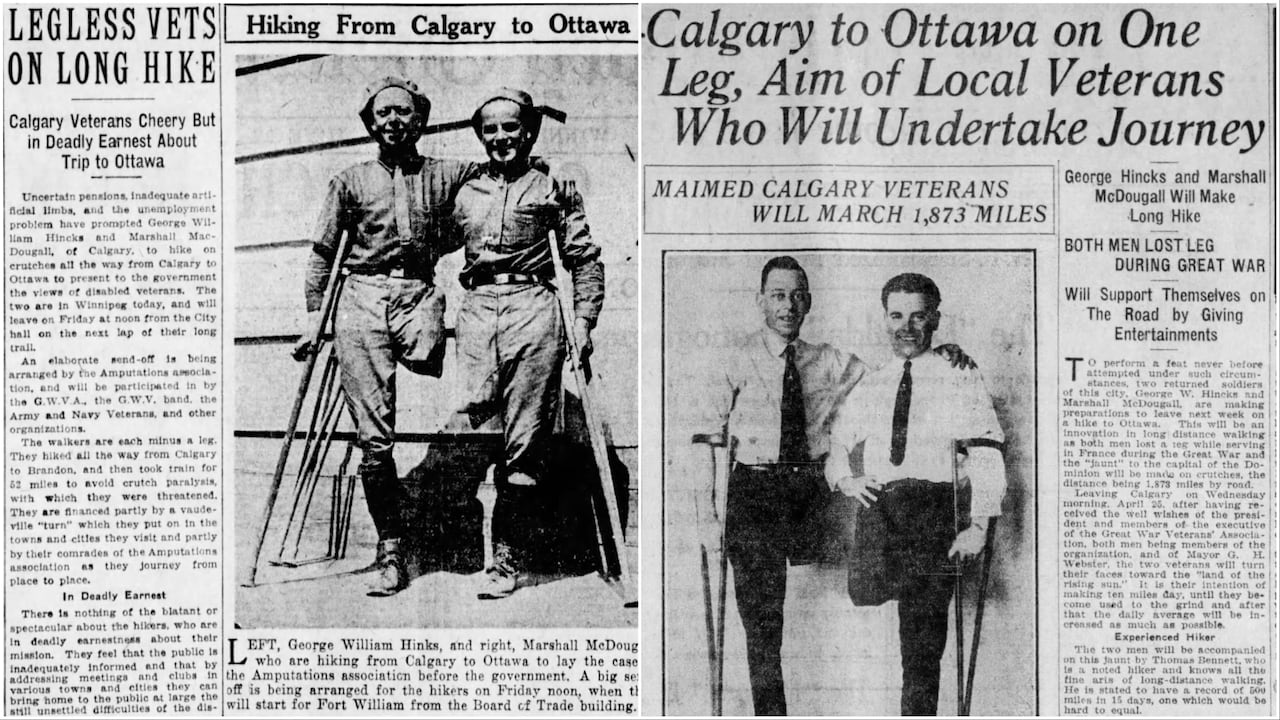 Historian Eric Story traced Hincks and McDougall's trek as it was told in Canadian newspapers at the time. (Winnipeg Evening Tribune, Calgary Daily Herald)
Historian Eric Story traced Hincks and McDougall's trek as it was told in Canadian newspapers at the time. (Winnipeg Evening Tribune, Calgary Daily Herald)Story, who traced the pair’s journey in newspaper coverage at the time, said the soldiers emerged from the war during a time when Canada was transitioning “from a rural agricultural society to one that was very much powered by industrial capitalism."
“It was in that transformation that people with disabilities were [beginning] to be regarded as inefficient workers and ultimately unproductive members of society because their bodies were not conformed to the tasks of an industrial capitalist society,” he said.
“These are kind of the ideas that Hincks and McDougall are really trying to tackle in their trek ... to show Canadians that they were not inefficient workers, they were not unproductive members of society. The very opposite, actually. They are trying to show that they had as much grit — even more grit — than other Canadians.”
The journey, indeed, took a lot of grit. While the duo initially planned to walk from Calgary to Ottawa, they called off the trip in Thunder Bay, Ont., because they were under too much physical duress. Decades later, Fox also ended his Marathon of Hope just outside the northern Ontario city, where a bronze statue of the young runner was unveiled in 1982.
“They endured just immense amounts of pain and suffering on their trip,” Story said of the war veterans.
“Their armpits were literally rubbed raw. Open red sores under their armpits from the chafing between their crutches and their armpits. And so, you know ... it's an incredible story of endurance, of grit and determination.”
Early pioneers of disability rightsNot only did Hincks and McDougall hit the road almost six decades before Fox; they did it more than 20 years before the era that’s widely cited as the birth of the disability rights movement in Canada, Story said.
“They were able to shape individual Canadians' attitudes, change some of those attitudes, but also remind Canadians that the onus wasn't just on those disabled veterans who were struggling in the postwar world, but it was also incumbent upon able-bodied Canadians to confront some of their own attitudes,” he said.
“There is a lot more work that's done by later generations of disability rights advocates tackling those exact same issues. But I think it's important for Hinks and McDougall that they sort of laid the foundations.”
 Members of the Amputation Club of B.C. are shown in Vancouver in November 1918. Clubs like this would eventually amalgamate into the Amputations Association of the Great War, a predecessor to the Canadian charity War Amps. (Stuart Thomson Fonds/City of Vancouver Archives)
Members of the Amputation Club of B.C. are shown in Vancouver in November 1918. Clubs like this would eventually amalgamate into the Amputations Association of the Great War, a predecessor to the Canadian charity War Amps. (Stuart Thomson Fonds/City of Vancouver Archives)Both soldiers were members of the Amputations Association of the Great War, a predecessor of the War Amps, a Canadian charity that began by assisting veteran amputees but now serves all amputees in Canada.
"Hincks and McDougall seem to have had the same positive attitude that was so characteristic of the First World War amputee veterans who founded the War Amps, who lived by the motto, 'It's what's left that counts,’” Merrill Loeppky, War Amps regional representative for Manitoba, told CBC in an email.
“We have seen the unending courage and determination of the amputee community over the years to not only accomplish great things and overcome challenges, but to raise awareness of life as an amputee just like Hincks and McDougall did."
Lauren McDougall, meanwhile, said she’s honoured to be connected to this piece of Canadian history.
“I'm totally proud,” she said. “It's still a conversation that is relevant to today and to some of the biases and mindsets that are still in place, you, know a hundred years later."


